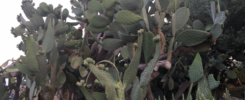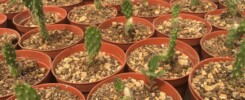Rotational Grazing – Cactus Feeding: A Growing Trend
Let’s discuss a growing trend in cattle feeding: cactus feeding and rotational grazing. This sustainable and affordable method is gaining popularity among ranchers. The approach involves adding cactus, like prickly pear, to cattle’s diet, providing them with nutrient-rich and water-filled food. Let’s explore this innovative idea.
Sustainability and Affordability
Cacti are sturdy plants that thrive in dry and semi-dry areas where other plants struggle. By using cacti as cattle food, ranchers can save on expensive feed supplements and depend less on traditional forage. This method also conserves water, as cacti store water and survive long dry periods. It’s a win-win for ranchers and the environment.
Safe Cactus Feeding for Cattle
To safely feed cattle with cactus, ranchers must remove spines and thorns to prevent injury. They should also slowly introduce cacti into the cattle’s diet, so their digestive systems can adjust. Following these steps, ranchers can ensure safe cactus consumption for their livestock.
Combining with Rotational Grazing
An exciting aspect of cactus feeding is its compatibility with rotational grazing. This practice involves moving cattle between pastures, allowing the land to recover. It offers many benefits like improved soil health, reduced erosion, and increased biodiversity. By adding cacti to cattle’s diet during rotational grazing, ranchers can further promote sustainable farming and livestock management.
Conclusion: A Sustainable Ranching Future
In conclusion, feeding cattle with cactus is a sustainable and affordable method gaining popularity among ranchers. It benefits both ranchers and the environment. By practicing proper safety measures and combining this method with rotational grazing, ranchers can support sustainable agriculture and livestock management for years to come.One of the best weblinks about rotational grazing is “Four Steps to Rotational Grazing” by Penn State Extension. This article provides a comprehensive guide to rotational grazing, including determining forage requirements, designing a grazing system, and monitoring animal performance and pasture productivity. [1]
Sources:
Pages
Categories
- Water conservation and management
- Walter Schroth
- Visitors and tourists to the Monti Iblei area of the province of Syracuse
- University
- Sustainable agriculture and farming practices
- Story
- Researchers and academics
- Recipes
- Policy and advocacy for arid regions
- Plant species and cultivation techniques suitable for arid regions
- People
- Members of the dryGrow Foundation
- ISHS
- Innovative technologies and solutions for arid regions
- Indigenous knowledge and traditions related to farming and land management
- Grazing Systems
- Grazing
- Foundation related
- Farmers and agricultural workers
- Education and outreach programs
- Contests
- Community-driven development and empowerment
- Climate change impacts and adaptations
- Carbon capturing
- Cactus World Characters
- Arid land management and conservation
- Animal Diets
Posts
- What was the trigger that prompted Walter Schroth to create dryGrow Foundation
- Donations
- X International Congress on Cactus Pear and Cochineal: 70. Control of pest cactus and cactus pests in Africa and reproduction performance of Dactylopius opuntiae
- X International Congress on Cactus Pear and Cochineal: 71. Control of pest cactus and cactus pests in Africa
- X International Congress on Cactus Pear and Cochineal: 72. Effect of tree tobacco leaf extracts on mortality rate of carmine cochineal
- X International Congress on Cactus Pear and Cochineal: 73. Dactylopius coccus Costa pest of beles, and ways for sustainable pest management and development in Tigray, Ethiopia
- X International Congress on Cactus Pear and Cochineal: 74. For an agroecological management of Dactylopius opuntiae (Hemiptera: Dactylopiidae)
- X International Congress on Cactus Pear and Cochineal: 75. Cactus – the New Green Revolution in Drylands: Functional response of the lady beetle, Hyperaspis trifurcata preying upon Dactylopius opuntiae (Hemiptera: Dactylopiidae)
- Combining Leucaena Hay and Cactus Pear for Crossbred Steers’ Diets
- How to make Nopal Flour
- The carbon-capturing potential of Opuntia species.
- Carbon Capturing Mechanisms in Opuntia
- Cactus Feeding & Rotational Grazing: A Sustainable Trend in Ranching
- Prickly Pear the drought-resistant crop
- Were we are – Monti Iblei Syracuse
- Opuntia Cactus: The Solution to Camel Herders’ Nutrition Challenge
- What is Micropropagation
- Exporting endemic Opuntia from Mexico
- Professor Paolo Inglese University of Palermo
- Unlocking the Potential of Opuntia Ficus Indica: Prof. Stefano La Malfa
- San Cono’s Secret
- The magic of the Fico d’India
- Prof. Jose Dubeux a Pioneer in Promoting Sustainable Use of Cacti
- USE of LED Lights for growing Cactus
- A Beacon of Hope for Adigrat University and Sustainable Agriculture
- Who is Djalma Cordeiro Dos Santos?
- About Orelha de Elefante Clones
- University research
- Get involved
- Biomass – Opuntia – What we do and offer
- dryGrow`s 1st Photo & Video contest (closed)
- Geographical Areas-Resources

